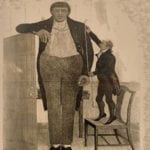 Weird Stuff
Weird Stuff  Weird Stuff
Weird Stuff  Our World
Our World 10 Ways Your Christmas Tree Is More Lit Than You Think
 Movies and TV
Movies and TV The 10 Coolest Stars to Set Sail on The Love Boat
 History
History 10 Things You Didn’t Know About the American National Anthem
 Technology
Technology Top 10 Everyday Tech Buzzwords That Hide a Darker Past
 Humans
Humans 10 Everyday Human Behaviors That Are Actually Survival Instincts
 Animals
Animals 10 Animals That Humiliated and Harmed Historical Leaders
 History
History 10 Most Influential Protests in Modern History
 Creepy
Creepy 10 More Representations of Death from Myth, Legend, and Folktale
 Technology
Technology 10 Scientific Breakthroughs of 2025 That’ll Change Everything
 Weird Stuff
Weird Stuff Ten Bizarre Facts About The Doge Meme
 Our World
Our World 10 Ways Your Christmas Tree Is More Lit Than You Think
 Movies and TV
Movies and TV The 10 Coolest Stars to Set Sail on The Love Boat
Who's Behind Listverse?

Jamie Frater
Head Editor
Jamie founded Listverse due to an insatiable desire to share fascinating, obscure, and bizarre facts. He has been a guest speaker on numerous national radio and television stations and is a five time published author.
More About Us History
History 10 Things You Didn’t Know About the American National Anthem
 Technology
Technology Top 10 Everyday Tech Buzzwords That Hide a Darker Past
 Humans
Humans 10 Everyday Human Behaviors That Are Actually Survival Instincts
 Animals
Animals 10 Animals That Humiliated and Harmed Historical Leaders
 History
History 10 Most Influential Protests in Modern History
 Creepy
Creepy 10 More Representations of Death from Myth, Legend, and Folktale
 Technology
Technology 10 Scientific Breakthroughs of 2025 That’ll Change Everything
10 Real-Life People Ripped Out Of A Fantasy Story
You don’t need J.K. Rowling or C.S Lewis to enter a world full of magic. You just need to walk down the street. While there aren’t any real-life fairies or trolls lurking about, planet Earth is full of crazy characters who seem like they were ripped straight out of the pages of a fantasy novel.
If you want to find these fascinating figures, just wish really hard, shout “I believe in Listverse!” and check out the 10 amazing men and women below.
10The Mushroom Musician
Magic forests are a pretty common trope in fantasy, especially if you’re reading anything by J.R.R. Tolkien. However, trees aren’t the only enchanted organisms growing in the woods. If you listen long enough, you might hear music coming from the forest floor. And who’s responsible for this woodland melody? The mushrooms, of course. Well, that’s what Vaclav Halek believed, anyway. Whenever this Czech composer spotted a black morel or a toadstool, suddenly the whole world was filled with mycological music. And we’re not talking simple inspiration. Halek really thought the mushrooms were singing.
His odd relationship with fungi started in the 1980s, during a mushroom hunt outside of Prague. Halek was preparing to take a photo of a lone fungus when he heard the sounds of string instruments and flutes. Ecstatic, the musician grabbed a notepad and started taking dictation, visiting every mushroom in the forest and listening to its unique song. Soon, he had an entire mushroom symphony. According to Halek, every mushroom has its very own melody. “I think that every mushroom has its own idea which the Creator breathed into it,” he once said, “and that it’s possible to hear this idea if we’re modest enough and if we ask the mushroom nicely to sing it for us. I’ve always been able to hear it.” That’s why Halek spent his days wandering parks and forests, picking mushrooms and jotting down their little songs.
During his lifetime, the man composed over 5,000 different pieces of music, all based on mushrooms, and each song has its own important meaning. According to Halek, one is about “enjoying freedom but knowing that it will end soon” while another sounds like “the neverending cosmos, like you can see in the deep space pictures taken by the Hubble telescope.” Ultimately, Halek wanted to glorify God and capture a sense of wonder about the universe. Sadly, the mushroom musician passed away in 2014, leaving the world a little less magical.
9The Wandering Goat Man
Okay, we’re not talking about the axe-wielding monster that attacks cars in Maryland. We’re talking about Charles “Ches” McCartney, a kind of real-life Radagast the Brown. While McCartney wasn’t magic, he sported an impressive beard, was an eccentric loner, and relied on an unusual method of transportation. While the Brown Wizard used Rhosgobel Rabbits, McCartney traveled across the US in a ramshackle wagon pulled by goats.
The story goes, he was born in Iowa in 1901 and ran away from home at 14. He eventually ended up in New York, where he married a knife-thrower 10 years his senior, a lady who earned her living by chucking daggers at our hero. In 1935, he got a job clearing forests for the Works Progress Administration, only one of those trees nearly crushed him to death. Legend has it McCartney didn’t wake up until the mortician tried to inject him with embalming fluid. Whether or not that’s accurate, McCartney’s life radically transformed after his near-death experience. He became a fire-and-brimstone preacher, ready to save the US from its sins. So he bought a wagon, loaded it with pots, pans, and aluminum signs, and hooked his carriage to a team of 12–30 goats. He was ready to hit the open road.
McCartney and his four-legged friends made their way across the back roads of America, blocking traffic and spreading the gospel. As you might expect, the preacher lived a rather unusual lifestyle. He rarely showered and drank a whole lot of goat’s milk. He spent his free time reading the Bible and Robinson Crusoe, and whenever he ran across strangers, he’d regale them with stories and try to sell them postcards of the “Goat Man” himself. During his travels, McCartney visited Canada and 49 states (sorry, Hawaii). Wherever he went, he’d let his special two-legged goat sit up front with him on the buckboard.
Eventually, McCartney started a mission in Jeffersonville, Georgia that served as his base. Of course, life was dangerous for a man on the road, and McCartney was mugged multiple times. Once, some crooks even killed two of his goats. His wandering days finally ended in 1985, when he went to California to marry the actress Morgan Fairchild. Only when he showed up in Los Angeles, he was severely beaten and sent back to Georgia. Ches McCartney spent his final days in a southern nursing home where he passed away at 97 . . . though some say he was over 120.
8The Right-Handed King Of Hohoe

If you spotted Cephas Bansah walking down the street, you’d probably think he was just a normal guy. He’s 66, married, and runs a garage in the city of Ludwigshafen, Germany. Bansah seems like an average, run-of-the-mill working man . . . well, during the day, anyway. At night, after he’s closed up the garage, Bansah transforms from a mechanic into a monarch. Bansah originally hails from Ghana, but during his teenage years, he left his homeland for Europe where he went to school as a foreign exchange student. After meeting his future wife, he decided to stay in Germany and was probably content to spend the rest of his life working as a mechanic . . . only fate had slightly different plans for Mr. Bansah.
As it turns out, Cephas has royal blood coursing through his veins. His grandfather was king of the Hohoe area of southeastern Ghana, but after he passed away in the late ’80s, there was some dispute about who should take his place. Normally, Bansah’s dad or his older brother would get the job, only there was one problem. Both men were left-handed. Lefties have had it pretty rough, historically speaking, and in Bansah’s tribe, southpaws were considered unclean and dishonest. So with the elder Bansahs out of the way, the job fell to right-handed Cephas. (The fact he lived in Germany and could use his connections to send supplies back to Ghana probably was a factor as well.) However, Bansah didn’t really want to move back to Africa, so he rules his country from his home in Ludwigshafen. After a long day at work, he speaks to his people via Skype and makes decisions on tribal arguments.
In addition to mediating disputes, Bansah has done quite a bit of good for his 200,000 subjects. He’s supplied his people with water purification equipment, ambulances, generators, and doctors. He visits his empire about six times a year, has helped pay tuition for schoolchildren, and was even responsible for building a much-needed bridge. And yes, King Togbe Ngoryifia Cephas Kosi Bansah even has his own crown and royal golden chains. Sadly, thieves broke into his home last year and made off with the royal jewels, but no crook can keep the right-handed king of Hohoe from effectively ruling his kingdom.
7The Great American Rainmaker
Charles Hatfield was either a genuine magician or the greatest con man of all time. As a young man in the 1900s, Hatfield worked in his father’s Los Angeles sewing machine company. He was a door-to-door salesman, expecting to take over the family business someday. Only Hatfield had much bigger plans. He spent his free time reading up on shamanic rituals and combing through books like “The Science of Pluviculture.” “Pluviculture” is just a fancy way of saying “rainmaking.”
Loaded with a library full of knowledge, Hatfield started experimenting and soon developed the perfect recipe of 23 mysterious chemicals. With the help of his brother Paul, Hatfield would erect 6-meter-tall (20 ft) towers, climb up to the top, and cook his chemical soup in a cauldron. As the broth evaporated, Charles claimed the chemicals would cause clouds to precipitate, and then . . . cats and dogs would start to fall. Soon, Hatfield was known across America as a genuine rainmaker. He traveled from California to Mississippi, bringing rain to drought-stricken towns everywhere he went. Newspapers praised his name, and desperate people gladly shoveled out thousands upon thousands of dollars for his services. And Hatfield always delivered. Wherever he went, the rain showed up, but critics claimed he was tracking the weather and knew when and where to show up.
Eventually, Hatfield was given the opportunity to silence his haters forever. The city of San Diego was experiencing a horrible drought that was killing crops, wrecking the economy, and jeopardizing an upcoming exposition. Willing to take a gamble, the city council offered Hatfield $10,000 to fill the Lake Morena Reservoir . . . and did they ever get their money’s worth. On January 1, 1916, Charles and Paul built multiple towers and filled multiple cauldrons with their magic broth. And that’s when the heavens broke loose. Winds of up to 100 kilometers per hour (60 mph) tore through the city, gallons of rain fell from the sky, and massive floods wiped away entire houses. Giant waves crashed through the streets, telephone poles collapsed, and somewhere between 20–50 people were drowned.
When the rain was done, and Hatfield showed up to collect his check, the San Diego officials were not pleased, especially since so many citizens were filing millions of dollars in claims. The authorities refused to pay Hatfield his $10,000 . . . unless he took full responsibility for the results of the storm. Infuriated, Charles admitted it was all just a big coincidence and returned to his job as a sewing machine salesman. Eventually, the rainmaker died in 1982, leaving behind an incredibly strange tale that inspired a movie starring Burt Lancaster. No one ever discovered what chemicals Hatfield used in his rainmaking recipe.
6Headmaster Of The Icelandic Elf School
As we’ve read before, people in Iceland take elves very seriously. According to a poll conducted in 2006, 56 percent of Icelanders think these pointy-eared creatures might actually exist. Some people keep little elf homes in their gardens in case the sprites need a place to sleep, and a highway construction project was once held up thanks to activists worried the roads might disturb elf habitats.
One such elf aficionado is Magnus Skarphedinsson. He’s spent over 30 years interviewing hundreds of people who’ve experienced close encounters of the elfin kind. One witness claims a rock outside his farm transformed into a magical church, complete with a handsome priest. Another alleged an elf stole her scissors only to return them a week later. As for Skarphedinsson, he’s never actually seen an elf himself but claims he can tell the difference between all 13 species, to say nothing of gnomes, trolls, and fairies.
Fortunately, Skarphedinsson wants to share his knowledge with the world. That’s why he opened an elf school in Iceland’s capital of Reykjavik. Located on Sidumuli Street—for any interested travelers or natives–—Skarphedinsson’s classroom is full of mystical books, fiber-optic plants, and stereotypical elf statues which, according to the headmaster himself, don’t actually look anything like real elves. Classes start at three in the afternoon every Friday and generally last around three or four hours. Students learn about how elves spend their time fishing and farming, are pretty good at predicting the future, and once warned mankind about the differences between good and evil. In addition to lecturing about the mysterious world of the Hidden People, Skarphedinsson hands out study books and diplomas if you pass the course.
Of course, you’re probably wondering why Skarphedinsson believes in elves if he’s never actually seen one. Believe it or not, this actually troubled the headmaster himself, and he asked a clairvoyant friend what was going on. Well, according to the psychic, all the elves agreed to never reveal themselves to Skarphedinsson because he’d probably ask them too many questions.
5The Real-Life Willy Wonka
He doesn’t enslave green-haired dwarves or drown children in chocolate rivers, but those details aside, Charlie Harry Francis is essentially the real-life Willy Wonka, complete with top hat. Only instead of candy, Francis specializes in ice cream. Francis is the mad genius behind Lick Me I’m Delicious, possibly the most magical ice cream company on the planet. The flavors Francis churns out make Ben & Jerry’s look like McDonald’s. If you can think of a flavor, Charlie can conjure it up. He’s created ice cream that tastes like roast beef, cheddar cheese, and brussels sprouts, but that’s just scratching the surface of his culinary craziness.
One of his wildest treats is the ice cream that glows in the dark. The secret ingredient is calcium-activated proteins extracted from bioluminescent jellyfish. When you lick the ice cream, it lights up in the dark, like some sort of deep-sea sorbet. As you might expect, it’s pretty pricey, with one scoop costing $225.22, but this is nothing compared to his most infamous concoction . . . “The Arousal.” This adult dessert was commissioned by an anonymous celebrity who seems to have had a little bit of trouble in the bedroom. Each scoop of “The Arousal” comes with 25 milligrams of Viagra and tastes just like champagne. Originally, Francis wanted this edgy ice cream to taste like oysters, only when he actually tried it out, it was reportedly quite disgusting.
Francis claims he’s currently working on the world’s hottest ice cream. The idea is to create a scoop that’s served at 54 degrees Celsius (129 °F) while on fire and full of chillies that will absolutely murder your taste buds. Whether it’s possible (or whether he’s joking) remains to be seen, but if there’s anyone who can do it, it’s the Edible Inventor.
After all, he’s the guy responsible for the nitro ice cream buggy, an icy cold carriage that uses a nitrogen injection system to create instant ice cream. He’s also assembled an edible mist machine that produces flavorful fog. Stick out your tongue, and you might taste apple pie, chocolate cookies, or even lemon meringue. A few of his other amazing inventions include an ice cream pottery wheel, an instant lollipop maker, and a washing machine that makes chicken soup. Hopefully, one day Mr. Francis will launch a golden ticket contest, because we really want to take a tour through his factory.
4The Warrior Woman Of Asgarda
Back in the days of ancient Greece, you didn’t want to screw around with the Amazons, especially if you were a dude. These female fighters were said to cut off their breasts so they could fire arrows with more accuracy and supposedly castrated their male children. Long thought to be a myth, recent archaeological discoveries indicate the Amazons might’ve actually existed outside the pages of Greek mythology. But according to Katerina Tarnouska, they’re still around today.
Tarnouska is a Ukrainian preschool teacher, but that’s just her side job. Her real mission is to train a new generation of warrior women, and she’s more than equipped for the task. Tarnouska is a kickboxing world champion and—according to her—a descendant of the Amazons. She believes the Amazons once resided in the Ukraine and says their spirit lives on in modern-day Ukrainian women. Hoping to show other females the path to Amazon enlightenment, she’s opened a training camp in a valley near the Carpathian Mountains, where women spend their summers studying martial arts.
The women call themselves the Asgarda, and since 2002, over 1,000 women have trained under Tarnouska’s tutelage. Each day starts off with an early morning run, yoga, and a bath in a nearby stream. Afterward, Tarnouska lectures the girls on subjects like Ukrainian history and the importance of females in society. Of course, the highlight of the day is martial arts practice. Their fighting style is based on the traditional Hopak dance and employs all sorts of weapons like swords, nunchakus, and scythes. According to Tarnouska, it’s the only martial arts developed specifically for women.
However, while these ladies could kick your head off your shoulders, there’s one significant difference between the Asgarda and the Amazons. Tarnouska and her band don’t actually hate men. In fact, the Asgarda are all about finding a “warrior man,” getting married, and making warrior babies. Tarnouska believes mothering a generation of tough Ukrainians is the key to saving her country. Of course, she thinks women should pursue a career if they want, but after they find fulfillment, they should find a husband and settle down. It’s an odd philosophy for someone who claims the title of “Amazon” . . . but we wouldn’t say that to her face.
3The Dollmaker Of Nagoro
Once upon a time, the Japanese town of Nagoro was a thriving little community, but as the years went by, more and more people disappeared, leaving the village for bigger cities and better jobs. Soon, Nagoro was nothing more than a ghost town, home to just 35 lonely souls. If you visited the town today, you’d find empty homes, deserted streets, and an abandoned school.
And hundreds of life-size dolls.
The dolls lean against houses and sit on park benches. Some are busy plowing fields, while other spend their time fishing. A few wear business suits, others are dressed like construction workers, but almost all of them stare at the world through black button eyes, like something out of a Neil Gaiman novel.
Where did these dolls come from, and why are they there? Well, you should probably ask Ayano Tsukimi. She was born in Nagoro, and like many of her neighbors, she eventually packed her bags and moved to Osaka. However, after years away from home, she finally went back to care for her elderly father. When she returned to Nagoro, Tsukimi tried her hand at gardening and decided to create a life-size scarecrow that resembled her dad. And that’s when Tsukimi started making dolls in earnest. Inspired by the scarecrow, she wanted to sew one doll for every person who’d left the village or passed away. Today, there are around 350 dolls in Nagoro, some perched in trees, others huddled together outside shops, and some sitting at their desks in the creepiest schoolroom in the world.
However, Tsukimi doesn’t see her dolls as eerie. When she talks about her uncanny creations, her voice is actually full of nostalgia, because these aren’t just dolls. They’re memories. “That old lady used to come and chat and drink tea,” she says, describing one of her button-eyed neighbors. “That old man used to love to drink sake and tell stories. It reminds me of the old times, when they were still alive and well.”
2The Man Who Grows Grapes With Magic
Nicolas Joly is not your ordinary vintner. Located in Savennieres, a commune nestled in France’s Loire Valley, Joly’s vineyard produces some of the greatest white wine in the world. Only Joly’s methods for producing top-notch alcohol are a little . . . unusual. This French winemaker—who actually prefers to be called a “nature assistant“—doesn’t rely on modern methods. Instead, Joly uses magic.
Before he was interested in grapes, Joly was an investment banker in New York and London. However, in 1977, he grew tired of the financial game, returned to his parents’ vineyard in France, and took over the family business. Only Joly planned on shaking things up a bit. After reading a book by Rudolf Steiner, a 19th-century philosopher who blended science and spirituality, Joly was inspired to practice biodynamic farming. Basically, biodynamics eschews modern agricultural techniques in favor of harnessing cosmic forces. For example, Joly times his plantings in accordance with the Sun, Moon, and planets. He also puts a lot of thought into making the best manure possible. That’s why he stuffs cow horns full of cow dung and buries the bones during the winter. While they’re under the ground, the horns absorb the “life force” from the Sun, which turns the dung into awesome fertilizer.
Joly also relies on other special preparations—like oak bark, chamomile, and dandelion—to soak up forces emanating from other planets. Similar to the cow dung, Joly puts these preparations in various animal body parts (chamomile goes inside cow intestines, oak inside a sheep’s skull) and buries them across his property. Of course, all these preparations are mixed with water beforehand and spun in a massive machine, a process that dynamizes his mixtures by allowing the physical world to interact with the world of “energies.” Once the wine is bottled, Joly plays music to his alcohol, and if he’s like most other biodynamic farmers, chances are good his cellar is free of metals. Proponents of biodynamics believe that metal causes electric pollution, and that’ll spoil the wine. Sure, it sounds weird, but Joly doesn’t care if you think he’s crazy. And since his wines are generally considered the best of their kind, he must be doing something right.
1The Man At The Center Of The World
Jacques-Andre Istel has talked to a dragon, lives at the center of the world, and has built his very own pyramid. If that doesn’t sound like someone ripped out of a fantasy novel, then we don’t know what does. Istel was born in Paris in 1929, but when the Nazis rolled into town, his family fled to America. Istel eventually became a stock analyst, but soon left Wall Street to open a series of skydiving schools. But while parachutes were his passion, his dream was to build a town. In the 1980s, Istel sold his skydiving business and moved out to California, where he’d purchased 2,600 acres in the middle of the desert. The Frenchman christened his little empire “Felicity” and soon declared his town was the center of the world. Only Istel wanted the government to recognize his claim, so he devised a truly wacky scheme.
Hoping to sway the county board of supervisors, Istel wrote his very own children’s book titled Coe: The Good Dragon at the Center of the World, a story about a dragon who winds up in Felicity and meets Istel himself. Next, he donned a tuxedo, hired several high school trumpeters to announce his presence, and showed up in front of the council, claiming he was the “ambassador of all good dragons.” Armed with the book, Istel implored the council to declare Felicity the center of the world . . . which they did.
Next, the Frenchman built a 21-story pyramid to mark the middle of the globe. In addition to the pyramid, he elected himself mayor of Felicity, built 12 apartments for anyone who wanted to live in his town, and erected a little white chapel atop a man-made hill, even though he’s not religious. He constructed a spiral staircase that leads to nowhere, a sundial that looks like Michelangelo’s Arm of God, and even opened a post office. To mark the occasion, he asked a Chinese diplomat to give a speech in Mandarin.
Of course, nothing compares to his “history of the world.” Located in the center of Felicity are lines of granite panels, each anchored 1 meter (3 ft) into the ground so they’ll stand for 4,000 years. Istel has decorated these monuments with an eclectic collection of historical moments. There are images of Vincent Van Gogh paintings, Sandra Day O’Connor, and inventions like the safety pin. He’s recorded details about Viking funeral rites, cooking instructions from Julia Child, and 19th-century political cartoons. And every panel is complete with long passages of explanation, explaining the history of the world for curious visitors who’ll visit Felicity thousands of years in the future.



![10 Real Countries Straight Out Of The Handmaid's Tale [DISTURBING] 10 Real Countries Straight Out Of The Handmaid's Tale [DISTURBING]](https://listverse.com/wp-content/uploads/2019/11/offredandafghan-150x150.jpg)




